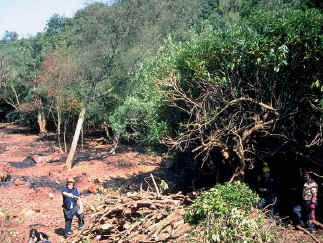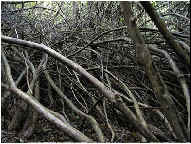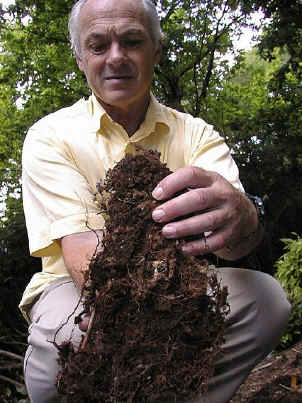Rhododendron ponticum
A killer of the Countryside
| Introduction to Britain |
Invasion by R ponticum |
Toxicity in Rhododendron | Inhibitory Effects |
Biodiversity in R ponticum | Habitat Restoration | Summary | Other Information |
Rhododendron ponticum is native to countries in the western and eastern Mediterranean such as Spain, Portugal and Turkey and also occurs eastwards to Asia. It is not native to Britain, but was first introduced in the late 18th Century. It became especially popular on country estates in Victorian times, providing ornamental value, as well as cover for game birds. Recent research indicates that British Rhododendron ponticum originates from Spanish and Portuguese introductions. R ponticum thrives in milder, wet climatic conditions, where there are poor, acidic soils. Unless established stands are constantly kept in check, they will expand into adjacent areas, rapidly eliminating the majority of native plant species. The twentieth century demise of many former country estates and the consequent lack of control of remaining R ponticum, has allowed this species to invade large areas of the British countryside. R ponticum invades areas both vegetatively and via seed. Established plants spread by lateral horizontal growth of the branches. A single plant may eventually end up covering many metres of ground with thickly interlaced, impenetrable branches. Where the horizontal branches touch the ground, they will root, continually extending the area of R ponticum cover.
For the same reason, streams can become completely overgrown and shaded out by R ponticum growing on the banks. This severely affects animal life in the stream. Fish such as trout depend upon invertebrates which fall off native bankside vegetation for 80% of their food. R ponticum seeds are tiny and hence wind dispersed. Each flower head can produce between three and seven thousand seeds, so that a large bush can produce several million seeds per year. Of course not all the seeds will grow successfully, but given the right conditions, a good many will germinate. Seedlings have difficulty becoming established in areas where there is already continuous ground cover from native plants. Establishment is best in disturbed areas where the native vegetation has been in some way disrupted, providing an opening in the plant cover. The seedlings also germinate well in areas covered in moss. This may be because of the water holding capacity of the mosses. Specific mycorrhizal (fungal) associations with the roots of R ponticum plants provide great competitive advantage and allow the plants to flourish in nutrient-poor soils. The mycorrhizae are specific to ericaceous plants. This includes heathers. R ponticum therefore has a huge advantage over other non-ericaceous plants which may not have their own mycorrhizal network. This may also explain why the plant is so successful at colonizing heathlands, as the heathers which exist there have already established suitable mycorrhizal networks. Potentially toxic chemicals, particularly 'free' phenols, and diterpenes, occur in significant quantities in the tissues of plants of Rhododendron species. Diterpenes, known as grayanotoxins, occur in the leaves, flowers and nectar of Rhododendrons. These differ from species to species. Not all species produce them, although Rhododendron ponticum does. These toxins make Rhododendron unpalatable to most herbivores. Phenols are most concentrated in the young tissues, such as young emergent leaves and buds. This provides a primary defense against herbivores, before the tissues have acquired the added deterrent of physical toughness found in older tissues. Young emergent leaf buds have the additional protection of a sticky exudate which also contains phenols. This physically discourages small invertebrates from eating the buds, because they get stuck in the exudate. Its poisonous nature must act as a further discouragement. Grazing animals are discouraged from eating Rhododendron foliage because of its toughness and unpalatability. The unpalatability is learned and cases of poisoning may result in animals such as sheep and cattle, if they ingest sufficient quantities because of extreme hunger or inexperience. The general toxicity of Rhododendron to herbivores means that it cannot usually be controlled by grazing. Cases of human poisoning are also known. Most are caused by the consumption of honey produced from Rhododendron flowers. This is known as 'Mad Honey Disease', or 'Honey Intoxication'. Cases of this have been recorded from as far back as 400 BC. It results in relatively short-lived intestinal and cardiac problems and is rarely fatal. The severity of symptoms depends on the amount of contaminated honey consumed. It is worth thinking carefully about the siting of bee hives if Rhododendron is a prominent feature of the area. Inhibitory Effects of Rhododendron There is some evidence for allelopathic interactions (the production of adverse effects on other species) between Rhododendron and other plants. This may include the inhibition of germination, or of establishment of the seedlings of competing species. Direct poisoning is a possibility. As noted above, the tissues of Rhododendron contain significant quantities of phenols and other potentially toxic chemicals. There is also evidence for the prevention of mycorrhizal development in roots of the seedlings of competing plant species. Research and debate in this field is on-going. Once R ponticum has invaded an area, few native plants survive. In woodlands only those trees which manage to grow above the level of the R ponticum canopy will persist. These of course, have a finite life span. On their death, there is no replacement because seedlings cannot become established under the lightless canopy. At this point, the R ponticum completely dominates the area. This is particularly noticeable in Silver Birch woodlands as this species is short lived.Once the native plants have disappeared, the animals which rely upon them either directly or indirectly for food cannot survive. Thus R ponticum areas are essentially barren. Even where trees exist above the R ponticum canopy, species such as woodland butterflies disappear. This is because the caterpillars of most woodland butterflies can only feed on the wildflowers and grasses which are found in the glades and rides of well managed woodland.
The toxicity of R ponticum and its alien status means that there are few animal species associated with it in Britain. However, a number of herbivorous invertebrate species have been linked to it. Most of these are not restricted or specific to R ponticum. It is important to bear in mind that just because a species has been found on R ponticum, it does not mean that it habitually lives there. It may have fallen or been blown into the R ponticum from neighbouring native plant species. The canopies of trees can contain vast numbers of individuals of different invertebrate species. It is common for these to fall or be blown off to locations other than their chosen habitat. Indeed the air can contain an astonishing variety and number of small organisms, including invertebrates. Spiders are even able to balloon hundreds of miles in air currents. Biomass (the total weight of individuals) of the species is also important. One individual of a species does not imply an association, whereas a plant covered in a great many individuals would tend to indicate some sort of relationship.Occasionally a few R ponticum leaves can be found which have obviously been eaten by an insect. However the toxicity of the leaves means that this may well have resulted in the subsequent death of the individual(s) concerned. R ponticum growth is in no way controlled by herbivores feeding on it in great numbers. Even if the odd, isolated herbivore can occasionally be found on R ponticum, there is certainly little in the way of biomass to feed carnivores such as other invertebrates and birds. There is also the added likelihood that any herbivore feeding on R ponticum would also contain toxins derived from the foliage.The flowers of R ponticum are very attractive to insects, particularly Bumble Bees. In the main flowering period of May/June, the exotic showy blooms monopolize the attentions of pollinating insects, virtually to the exclusion of all others. This means that the flowers of native plant species in the vicinity suffer from a lack of pollinating insects. As a result they may not successfully set seed. This is yet another way that R ponticum may be detrimental to competing native vegetation.All of this means that areas dominated by R ponticum have an exceedingly impoverished fauna in comparison to native habitats, both in terms of species and of biomass. If there is little eating the R ponticum, then it follows that there are few or no carnivores eating these herbivores and so also, few top carnivores. Song birds which feed on either seeds or invertebrates are reduced to trying to survive in smaller numbers by feeding in areas above or adjacent to the R ponticum. Once the song bird populations decline so do species such as sparrowhawks which predate upon them.Many broadleaf woodlands are capable of supporting a complex and interlinked rich diversity of plant and animal life. This is because there can be as many as four distinct layers of vegetation. These are:
Crucially, each layer supports a whole range of invertebrates which in turn support the larger and larger animals which make up the food chain. To put the value of native plants in perspective, a single species such as Willow, can support over 400 different species of insect and mite. There may well be hundreds or even thousands of individuals of each of the species present representing a large biomass. However it is not just woodlands which have suffered. Heathlands, which have declined by 75% in just the latter half of this century, have also been seriously affected. Once again, R ponticum dominates many such areas and as a consequence, the heathland plants and animals originally present have disappeared. It is hardly surprising therefore to find that habitat destruction, including that caused by R ponticum, is responsible for the disappearance of 150 species from Britain in 100 years.Restoring areas which have been colonized by R ponticum is not just a matter of cutting the vegetation. The plant is notoriously difficult and expensive to actually kill. The leaves are waxy and herbicide treatment must include a chemical additive to help break this surface down. Even then, where R ponticum is well established with a large root system, such herbicide treatment usually has to be done over several years. This is because herbicides do not translocate well through the plant.Techniques such as mist spraying or tractor application are usually out of the question in woodlands because of the risk to trees. There are a variety of techniques for the mechanical removal of R ponticum. These usually employ a tractor or tracked swing shovel with a rotary flail mounted on a moving hydraulic arm. In sensitive conservation areas such techniques may well not be appropriate. Such mechanical devices often leave a thick layer of smashed Rhododendron on the ground which may have to be removed using expensive manual labour.
Further problems exist because any serious infestation is likely to affect neighbouring areas which may not be in the same ownership. Unless these areas are cleared, the seeds as well as the limbs of the plant will encroach. Given time, a single plant can cover 100 metres² and grow to more than 10 metres high. This should be taken into account when making out a management plan. Each site is different but where there has been a significant presence of this plant and where it is present in adjacent areas, it is prudent to budget for a reinfestation figure of 15% per year after initial clearance. In summary: R ponticum is an introduced species. It is highly invasive where conditions suit it. R ponticum destroys habitats and thus whole colonies of native plants and animals disappear. Because it is so expensive to control and physically prevents access, land has been abandoned. However, such areas can be restored but reinfestation must be prevented. Clearance of an area of R ponticum is but the first stage of restoration. Subsequent control measures may take several years to eradicate the R ponticum. Even then a viable seed bank may exist for many years. On some sites eradication may not be possible because of reinfestation from adjacent uncontrolled areas. More information: Woodland restoration in a severely infested R ponticum woodland. Complete report and surveys. Information about allelopathy by cleared Rhododendron here. |


